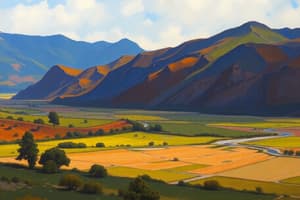Podcast
Questions and Answers
Which landform is characterized by elevated flatlands with steep sides?
Which landform is characterized by elevated flatlands with steep sides?
- Hill
- Mountain
- Plateau (correct)
- Valley
What distinguishes deserts from other landforms?
What distinguishes deserts from other landforms?
- High precipitation levels
- Sparsely vegetated areas (correct)
- Elevated landforms
- Presence of rivers
Which landform is generally used for agriculture due to its flat, low-lying characteristics?
Which landform is generally used for agriculture due to its flat, low-lying characteristics?
- Desert
- Hills
- Plain (correct)
- Mountain
Which of the following is a characteristic of valleys?
Which of the following is a characteristic of valleys?
What type of soil is considered ideal for agriculture due to its balanced moisture retention?
What type of soil is considered ideal for agriculture due to its balanced moisture retention?
Which biome is characterized by extreme temperatures and very little vegetation?
Which biome is characterized by extreme temperatures and very little vegetation?
Which land use involves the management of forests primarily for timber and conservation purposes?
Which land use involves the management of forests primarily for timber and conservation purposes?
What are fossil fuels primarily formed from?
What are fossil fuels primarily formed from?
Flashcards are hidden until you start studying
Study Notes
Land Forms
- Mountains: Elevated landforms, typically formed by tectonic forces.
- Examples: Himalayas, Rockies.
- Hills: Smaller than mountains, often with a rounded summit.
- Plains: Flat, low-lying areas often used for agriculture.
- Types: Coastal plains, interior plains.
- Plateaus: Elevated flatlands with steep sides, often found in arid regions.
- Examples: Colorado Plateau.
- Valleys: Low areas between hills or mountains, often with rivers.
- Deserts: Arid regions with sparse vegetation, defined by low precipitation.
- Examples: Sahara, Mojave.
Soil Types
- Clay: Fine particles, retains water well but drains poorly.
- Sand: Coarse particles, drains quickly but holds little moisture.
- Silt: Intermediate size, retains moisture better than sand.
- Loam: Mixture of clay, sand, and silt; ideal for agriculture.
Biomes
- Tundra: Cold, treeless regions with permafrost.
- Taiga: Coniferous forests in cold climates.
- Temperate Forests: Four distinct seasons, diverse flora and fauna.
- Grasslands: Dominated by grasses, found in places like the Great Plains.
- Deserts: Extreme temperatures, very little vegetation.
- Tropical Rainforests: High biodiversity, warm temperatures, and high rainfall.
Land Use
- Agriculture: Use of land for farming crops and raising livestock.
- Types: Subsistence, commercial.
- Urbanization: Expansion of cities into surrounding land.
- Forestry: Management of forests for timber and conservation.
- Mining: Extraction of minerals and resources from the land.
Natural Resources
- Fossil Fuels: Oil, coal, and natural gas formed from ancient organic matter.
- Minerals: Naturally occurring substances needed for technology and construction.
- Water Resources: Rivers, lakes, and aquifers essential for ecosystems and human use.
Environmental Issues
- Deforestation: Loss of forests due to agricultural expansion or logging.
- Soil Erosion: Loss of soil integrity due to wind or water, often exacerbated by human activity.
- Desertification: Transformation of fertile land into desert due to various factors, including climate change and deforestation.
- Climate Change: Impacts land through rising temperatures, changing precipitation patterns, and extreme weather events.
Land Forms
- Mountains are elevated landforms created by tectonic forces, with notable examples including the Himalayas and the Rockies.
- Hills are smaller land formations than mountains, typically characterized by rounded summits.
- Plains are flat, low-lying regions often utilized for agriculture, including types like coastal plains and interior plains.
- Plateaus are elevated flatlands featuring steep sides, commonly found in arid environments, such as the Colorado Plateau.
- Valleys represent low-lying areas situated between hills or mountains, often hosting rivers.
- Deserts are arid regions with minimal vegetation, defined by low precipitation levels, exemplified by the Sahara and Mojave deserts.
Soil Types
- Clay consists of fine particles that retain water effectively but have poor drainage capabilities.
- Sand features coarse particles that drain quickly, yet hold minimal moisture.
- Silt is of intermediate particle size, providing better moisture retention compared to sand.
- Loam is a balanced combination of clay, sand, and silt, making it ideal for agricultural use.
Biomes
- Tundra is characterized by cold, treeless landscapes with permafrost present.
- Taiga consists of coniferous forests found in cold climate regions.
- Temperate forests experience four distinct seasons, hosting diverse flora and fauna.
- Grasslands, predominantly covered with grass, are exemplified by regions like the Great Plains.
- Deserts have extreme temperatures paired with very sparse vegetation.
- Tropical rainforests boast high biodiversity, warmth, and significant rainfall.
Land Use
- Agriculture involves using land for farming crops and raising livestock, including types such as subsistence and commercial farming.
- Urbanization refers to the growth of cities into surrounding areas, affecting land availability.
- Forestry involves the management of forests aimed at timber production and conservation.
- Mining is the process of extracting minerals and resources from the earth.
Natural Resources
- Fossil fuels, such as oil, coal, and natural gas, originate from ancient organic matter.
- Minerals are naturally occurring substances crucial for technological advancements and construction needs.
- Water resources encompass rivers, lakes, and aquifers that are vital for both ecosystems and human utilization.
Environmental Issues
- Deforestation denotes the loss of forests due to agricultural expansion and logging practices.
- Soil erosion involves the degradation of soil integrity caused by wind and water, often worsened by human actions.
- Desertification is the process of converting fertile land into desert, influenced by climate change and deforestation issues.
- Climate change leads to rising temperatures and shifts in precipitation patterns, resulting in more extreme weather events that impact land.
Studying That Suits You
Use AI to generate personalized quizzes and flashcards to suit your learning preferences.




